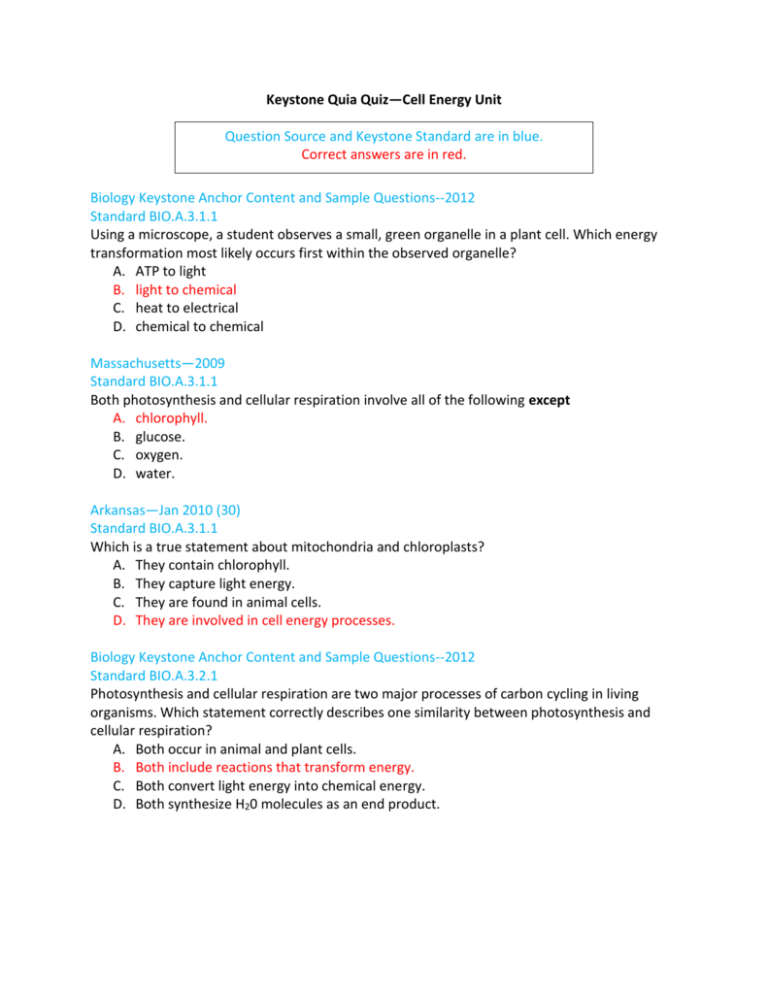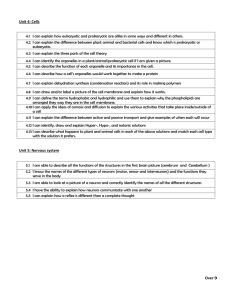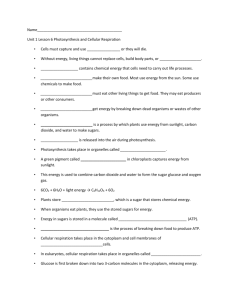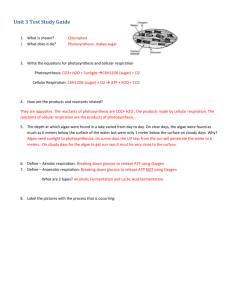Keystone Quia Quiz—Cell Energy Unit Question Source and
advertisement

Keystone Quia Quiz—Cell Energy Unit Question Source and Keystone Standard are in blue. Correct answers are in red. Biology Keystone Anchor Content and Sample Questions--2012 Standard BIO.A.3.1.1 Using a microscope, a student observes a small, green organelle in a plant cell. Which energy transformation most likely occurs first within the observed organelle? A. ATP to light B. light to chemical C. heat to electrical D. chemical to chemical Massachusetts—2009 Standard BIO.A.3.1.1 Both photosynthesis and cellular respiration involve all of the following except A. chlorophyll. B. glucose. C. oxygen. D. water. Arkansas—Jan 2010 (30) Standard BIO.A.3.1.1 Which is a true statement about mitochondria and chloroplasts? A. They contain chlorophyll. B. They capture light energy. C. They are found in animal cells. D. They are involved in cell energy processes. Biology Keystone Anchor Content and Sample Questions--2012 Standard BIO.A.3.2.1 Photosynthesis and cellular respiration are two major processes of carbon cycling in living organisms. Which statement correctly describes one similarity between photosynthesis and cellular respiration? A. Both occur in animal and plant cells. B. Both include reactions that transform energy. C. Both convert light energy into chemical energy. D. Both synthesize H20 molecules as an end product. Biology Keystone Anchor Content and Sample Questions--2012 Standard BIO.A.3.2.1 Which statement best compares the energy transformations of photosynthesis and cellular respiration? A. Only photosynthesis uses oxygen to create energy. B. Only photosynthesis causes an increase in kinetic energy. C. Photosynthesis and cellular respiration both store energy in chemical bonds. D. Photosynthesis and cellular respiration both require chemical energy to make food. Missouri—2008 session I Standard BIO.A.3.2.1 Which of these best explains the difference between the way animals and plants exchange gases with their environments? A. Animals use only photosynthesis, while plants use both photosynthesis and respiration. B. Animals use only respiration, while plants use both photosynthesis and respiration. C. Animals use both photosynthesis and respiration, while plants use only respiration. D. Animals use both photosynthesis and respiration, while plants use only photosynthesis. NY Regents—August 2010 (#41) Standard BIO.A.3.2.1 A biological process that occurs in both plants and animals is shown below. Which row in the chart below identifies the lettered substances in this process? A. B. C. D. Row 1 Row 2 Row 3 Row 4 Biology Keystone Sampler--2011 Standard BIO.A.3.2.2 Use the diagram below to answer question. The diagram shows the movement of ions against a concentration gradient to an area of higher concentration. Which molecule provides the energy needed for this movement to occur in a cell? A. ATP B. ADP C. catalase D. amylase Massachusetts—Feb. 2010 Standard BIO.A.3.2.2 An equation for a biochemical reaction is shown below. Which of the following happens during this reaction? A. Energy from ATP is used to make glucose. B. ADP adds a high-energy bond to its structure. C. ADP is metabolized to provide oxygen to a cell. D. Energy is stored in the molecule ATP for future use. North Carolina—2008(2) Standard BIO.A.3.2.2 Which most accurately describes the difference in ATP production between aerobic respiration and anaerobic respiration? A. Aerobic respiration produces more ATP than anaerobic respiration. B. Anaerobic respiration produces more ATP than aerobic respiration. C. Only anaerobic respiration produces measurable amounts of ATP. D. Anaerobic and aerobic respiration produce the same amount of ATP.








